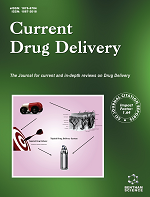- Home
- A-Z Publications
- Current Drug Delivery
- Previous Issues
- Volume 16, Issue 8, 2019
Current Drug Delivery - Volume 16, Issue 8, 2019
Volume 16, Issue 8, 2019
-
-
In vitro Lipolysis as a Tool for the Establishment of IVIVC for Lipid-Based Drug Delivery Systems
More LessAuthors: Ravinder Verma and Deepak KaushikIn vitro lipolysis has emerged as a powerful tool in the development of in vitro in vivo correlation for Lipid-based Drug Delivery System (LbDDS). In vitro lipolysis possesses the ability to mimic the assimilation of LbDDS in the human biological system. The digestion medium for in vitro lipolysis commonly contains an aqueous buffer media, bile salts, phospholipids and sodium chloride. The concentrations of these compounds are Read More
-
-
-
Crossing the Blood-Brain Barrier: A Review on Drug Delivery Strategies for Treatment of the Central Nervous System Diseases
More LessAuthors: Nur I. Mansor, Norshariza Nordin, Farahidah Mohamed, King Hwa Ling, Rozita Rosli and Zurina HassanMany drugs have been designed to treat diseases of the central nervous system (CNS), especially neurodegenerative diseases. However, the presence of tight junctions at the blood-brain barrier has often compromised the efficiency of drug delivery to target sites in the brain. The principles of drug delivery systems across the blood-brain barrier are dependent on substrate-specific (i.e. protein transport and transcy Read More
-
-
-
Novel Strategies for Targeting Prostate Cancer
More LessAuthors: Pritish K. Panda, Shivani Saraf, Ankita Tiwari, Amit Verma, Sarjana Raikwar, Ankit Jain and Sanjay K. JainProstate cancer (PCa) is a worldwide issue, with a rapid increase in its occurrence and mortality. Over the years, various strategies have been implemented to overcome the hurdles that exist in the treatment of PCa. Consistently, there is a change in opinion about the methodologies in clinical trial that have engrossed towards the treatment of PCa. Currently, there is a need to resolve these newly recognized challenges Read More
-
-
-
Efficient Delivery of Antisense Oligonucleotides by an Amphipathic Cell-Penetrating Peptide in Acinetobacter baumannii
More LessAuthors: Zhou Chen, Dan Nie, Yue Hu, Mingkai Li, Zheng Hou, Xinggang Mao, Xiaoxing Luo and Xiaoyan XueBackground: Carbapenem-resistant Acinetobacter baumannii (A. baumannii) was on the top of the list of the most threatening bacteria published by the WHO in 2017. Antisense oligonucleotides (ASOs) based therapy is a promising strategy for combating Multi-Drug Resistant (MDR) bacteria because of its high specificity, easy design and lower induction of resistance, but poor cellular uptake by bacteria has restricted the furth Read More
-
-
-
The Effect of Prescription on the Framework of Lipid Matrix and In Vitro Properties
More LessAuthors: Xiao-qin Chu, Yong Zhang, Jie Huang, Qian Li, Zheng-guang Li, Jian-qin Jiang and Shuang-ying GuiPurpose: To clarify the inner framework and relative properties in vitro of Lyotropic liquid crystal (LLC) based on various prescriptions by using hydrophilic sinomenine hydrochloride (SH) and lipophilic cinnamaldehyde (CA) as model drugs. Methods: Phase structures were checked by polarized light microscopy (PLM) and small-angle X-ray scattering (SAXS). Rheological studies and Attenuated Total Reflectance Fourier T Read More
-
-
-
In vitro Permeability and Bioavailability Enhancement of Curcumin by Nanoemulsion via Pulmonary Administration
More LessAuthors: Liying Shi, Youyang Qu, Zerong Li, Bin Fan, Hongfei Xu and Jingling TangBackground: Curcumin has shown considerable pharmacological activity, including antiinflammatory activity. Nevertheless, the pharmacological effect of curcumin may be limited because of poor water solubility, metabolizing rapidly and systemic elimination. Objective: In the current research, a novel curcumin nanoemulsion (Cur-NE) was developed for improving in vitro permeability and bioavailability via pulmonary a Read More
-
-
-
A New Food-grade Coenzyme Q10 Formulation Improves Bioavailability: Single and Repeated Pharmacokinetic Studies in Healthy Volunteers
More LessBackground: Coenzyme Q10 is a fundamental endogenous factor involved in cell energy production that shows protective properties in oxidative stress, mainly in skeletal and heart muscle. Coenzyme Q10 supplementation appears to benefit athletes in strenuous training and in the elderly, demonstrating ant-inflammatory properties by reducing inflammatory cytokines. Improved absorption of coenzyme Q10 via a new deliv Read More
-
-
-
Formulation and In Vitro Evaluation of Self Microemulsifying Drug Delivery System Containing Atorvastatin Calcium
More LessAuthors: Mine Diril, Gülbeyaz Yıldız Türkyılmaz and H. Yeşim KarasuluObjective: The aim of this study was to develop a new dosage form as an alternative to the classical tablet forms of atorvastatin calcium (AtrCa). The formulation strategy was to prepare an optimum self micro emulsifying drug delivery system (SMEDDS) to overcome the problem of low solubility of the active substance. Methods: In this study, pseudo ternary phase diagrams were plotted determined by the solubility studi Read More
-
Volumes & issues
-
Volume 22 (2025)
-
Volume 21 (2024)
-
Volume 20 (2023)
-
Volume 19 (2022)
-
Volume 18 (2021)
-
Volume 17 (2020)
-
Volume 16 (2019)
-
Volume 15 (2018)
-
Volume 14 (2017)
-
Volume 13 (2016)
-
Volume 12 (2015)
-
Volume 11 (2014)
-
Volume 10 (2013)
-
Volume 9 (2012)
-
Volume 8 (2011)
-
Volume 7 (2010)
-
Volume 6 (2009)
-
Volume 5 (2008)
-
Volume 4 (2007)
-
Volume 3 (2006)
-
Volume 2 (2005)
-
Volume 1 (2004)
Most Read This Month
Article
content/journals/cdd
Journal
10
5
false
en

Most Cited Most Cited RSS feed
-
-
Preface
Authors: Deng-Guang Yu and He Lv
-
- More Less

